



Table of Contents
- Introduction
- Benefits of Using a Rain Chain
- Types of Rain Chains
- Selecting the Right Rain Chain for Your Home
- Installation Process
- Maintenance Tips
- Creative Ways to Use a Rain Chain
- Conclusion
- Faq's
Rain chains are an aesthetically pleasing and functional alternative to traditional downspouts. Originating in Japan, these charming garden elements have become increasingly popular in homes worldwide, including in India. This article delves into the details of how to use a rain chain, its benefits, types, installation process, maintenance, and creative ways to incorporate it into your home.
Introduction
Rain chains, or "kusari-doi" as they are known in Japan, are a traditional yet innovative solution for managing rainwater. These decorative chains guide rainwater from the roof to the ground in a controlled manner, replacing the conventional downspouts. The cascading water creates a beautiful visual effect and produces a soothing sound, enhancing the aesthetic and auditory appeal of your home's exterior.
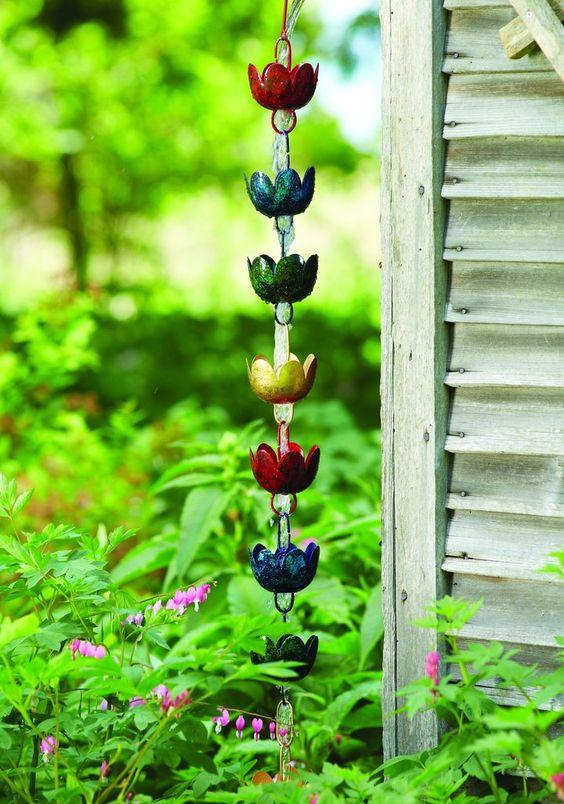 Rain Chain
Rain Chain
Image Source: Pinterest
In India, where monsoons are a significant part of the climate, effective rainwater management is crucial. Rain chains offer a functional and elegant way to handle heavy rains, directing the water to desired areas such as gardens or rain barrels. This not only helps prevent water damage to the home's foundation but also supports water conservation efforts by channeling rainwater for reuse.
Beyond their practicality, rain chains add a touch of charm and serenity to your home. They come in various designs, from simple chain links to intricate cup designs, making it easy to find one that complements your home's style. By integrating rain chains into your Indian home, you can enjoy both their utility and their contribution to the overall beauty of your property.
Benefits of Using a Rain Chain
- Aesthetic Appeal: Rain chains enhance the beauty of your home with their unique designs and the soothing sound of water flowing down the chain.
- Eco-Friendly: Made from materials like copper, brass, and aluminum, rain chains are recyclable and environmentally friendly.
- Water Harvesting: Rain chains can be integrated with rain barrels or garden areas to collect and utilize rainwater, promoting water conservation.
- Easy Installation: Unlike traditional downspouts, rain chains are easy to install and can be a DIY project.
- Versatility: They come in various designs, from simple chain links to ornate cups, making it easy to find one that suits your home's style.
|
Benefit |
Description |
|
Aesthetic Appeal |
Enhances home beauty with unique designs and soothing water sounds. |
|
Eco-Friendly |
Made from recyclable materials like copper, brass, and aluminum. |
|
Water Harvesting |
Can be integrated with rain barrels or gardens to collect rainwater. |
|
Easy Installation |
Simple to install and can be a DIY project. |
|
Versatility |
Available in various designs, from simple chain links to ornate cups. |
Types of Rain Chains
1. Link Chains
Link chains are the simplest and most traditional form of rain chains. They consist of a series of metal links connected together, forming a continuous chain. The simplicity of their design makes them highly versatile, allowing for easy customization in terms of length and appearance. Link chains are often chosen for their minimalist aesthetic and the gentle, cascading effect they create as water flows down the links.
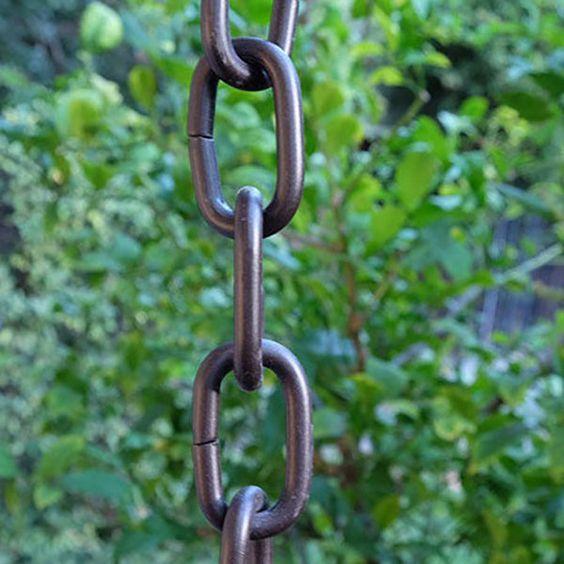 Link Style Rain Chain
Link Style Rain Chain
Image Source: Pinterest
2. Cup Chains
Cup chains feature a series of cups or funnels, each designed to catch and channel water downwards. These cups can vary in size, shape, and material, providing a wide range of design options to suit different architectural styles. The cup design ensures efficient water flow, even during heavy rains, as each cup collects and directs the water to the next one below. This type of rain chain not only enhances functionality but also adds an ornamental element to your home's exterior.
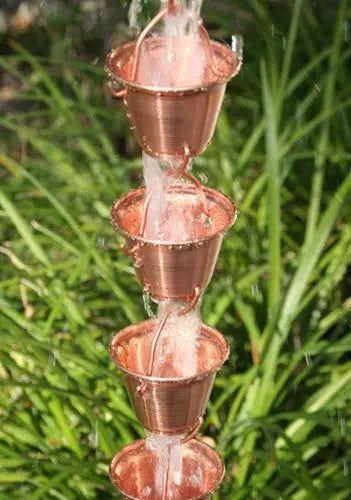 Cup Style Rain Chain
Cup Style Rain Chain
Image Source: Pinterest
3. Mixed Chains
Mixed chains combine elements of both link and cup chains, offering a unique blend of aesthetics and functionality. These chains might alternate between links and cups or integrate other decorative elements such as bells or leaves. The combination allows for efficient water management while providing a distinctive look that can complement various home designs. Mixed chains are ideal for homeowners who want the best of both worlds - the elegance of cup chains and the simplicity of link chains.
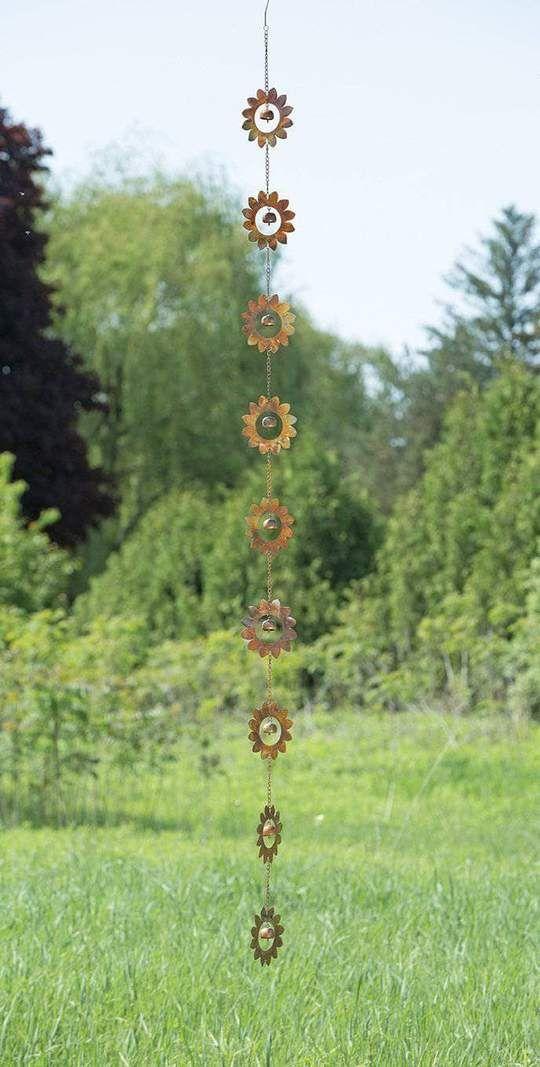 Flower Rain Chain
Flower Rain Chain
Image Source: Pinterest
Selecting the Right Rain Chain for Your Home
When selecting a rain chain for your Indian home, consider the following factors to ensure it meets your needs and enhances your home's aesthetics:
1. Material
Choose a material that suits your climate and personal preference. Copper and brass are popular choices due to their durability and the beautiful patina they develop over time. These metals are also resistant to rust, making them ideal for areas with high humidity. Aluminum is another excellent option, as it is lightweight, resistant to corrosion, and available in various finishes. Each material offers a different look and level of maintenance, so consider your local weather conditions and desired aesthetic.
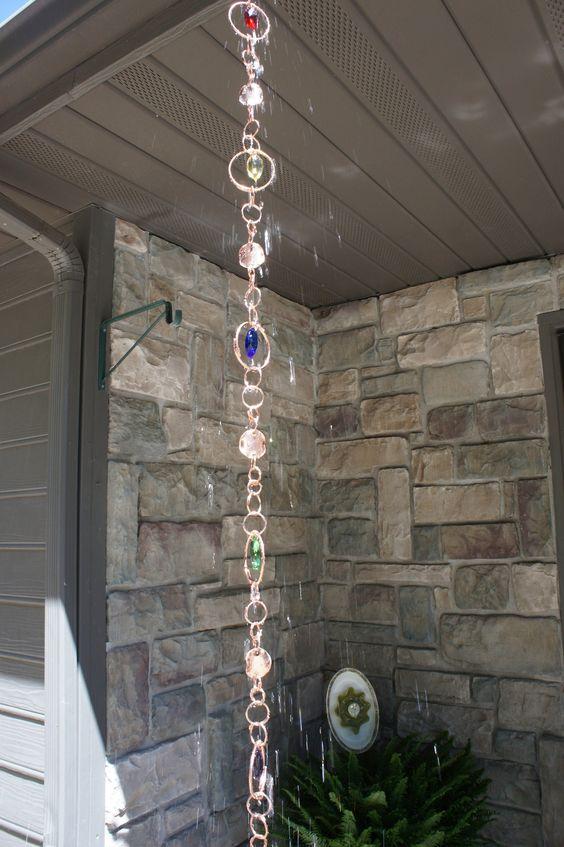 Copper and Crystal Rain Chain
Copper and Crystal Rain Chain
Image Source: Pinterest
2. Design
Select a design that complements your home's architecture and exterior decor. Ornate designs with intricate details add a traditional touch and are perfect for homes with classic or vintage aesthetics. On the other hand, sleek and modern designs suit contemporary homes, providing a minimalist and clean look. Whether you prefer simple link chains or elaborate cup chains, choose a design that enhances the overall appearance of your home.
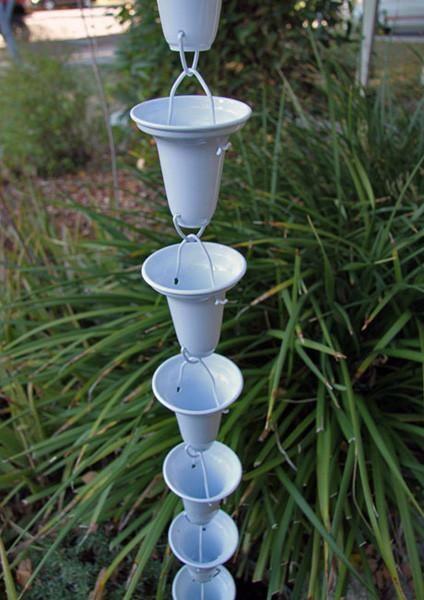 Aluminum Rain Chain
Aluminum Rain Chain
Image Source: Pinterest
3. Length
Ensure the rain chain is long enough to reach from the roof to the ground or the desired water collection area. Measure the distance from the gutter to the ground before purchasing a rain chain to avoid any gaps. Some rain chains come in standard lengths, but they can often be adjusted by adding or removing links or cups. Proper length is crucial for effective water management and aesthetic appeal.
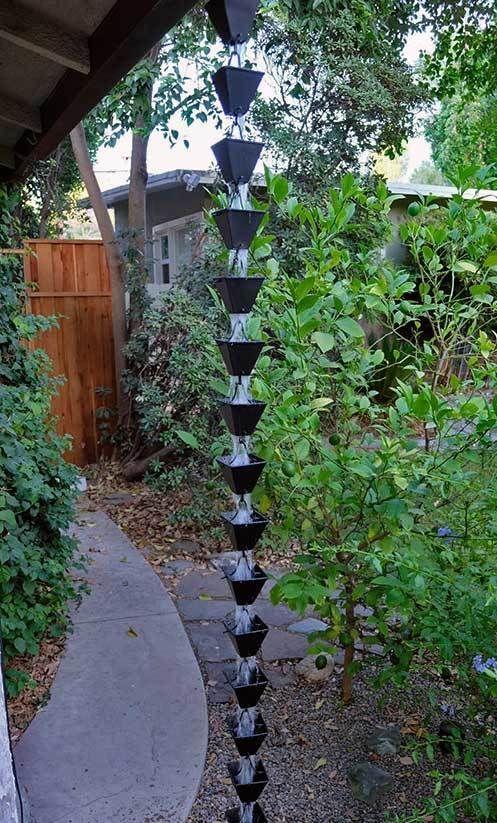 Long Rain Chain
Long Rain Chain
Image Source: Pinterest
4. Functionality
Consider the rainfall intensity in your area when choosing a rain chain. If you live in an area with heavy rainfall, opt for a cup chain for better water flow control. The cups can catch and guide large volumes of water more efficiently than link chains, preventing overflow and ensuring a smooth flow. For regions with moderate rainfall, link chains can be sufficient and provide a more subtle water display. Assessing your local weather patterns will help you choose the most functional rain chain for your home.
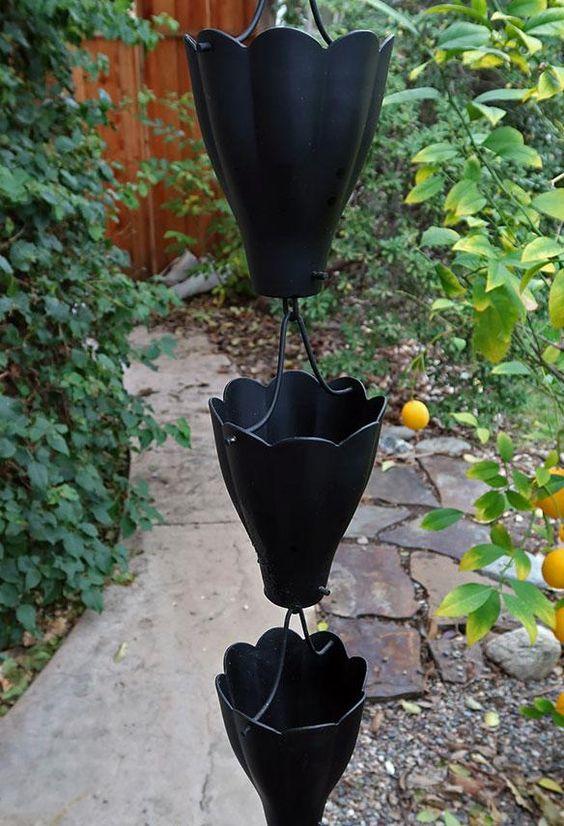 Rain Chain for Heavy Rain
Rain Chain for Heavy Rain
Image Source: Pinterest
Installation Process
- Prepare the Gutter: Remove the existing downspout and clean the gutter area where the rain chain will be installed.
- Install the Attachment: Attach the rain chain hanger or bracket to the gutter. Ensure it is securely fastened to support the weight of the rain chain and the water.
- Hang the Rain Chain: Hook the Rain Chain onto the hanger. If the chain is too long, adjust it by removing some links or cups.
- Anchor the Bottom: To prevent the chain from swinging in the wind, anchor the bottom using a rain chain basin, rain barrel, or a heavy stone.
Maintenance Tips
|
Tip |
Description |
|
Regular Cleaning |
Periodically clean the rain chain to remove debris and ensure smooth water flow. Use a gentle brush and mild soap to clean. |
|
Inspect for Damage |
Check for any signs of wear or damage, especially after heavy storms. Repair or replace damaged links or cups as needed. |
|
Seasonal Care |
In areas with harsh weather conditions, consider removing the rain chain during extreme weather to prevent damage. |
|
Polish Metal Chains |
If your rain chain is made of copper or brass, polish it occasionally to maintain its shine and prevent tarnish. Use a metal polish or a homemade solution. |
|
Lubricate Moving Parts |
Apply a light lubricant to any moving parts or connections to ensure they function smoothly and reduce the risk of rust or corrosion. |
Creative Ways to Use a Rain Chain
1. Garden Feature
A rain chain can be used to create a captivating water feature in your garden. Position the rain chain so that the water flowing down from it is directed into a small pond, bird bath, or fountain. This not only adds a soothing auditory element but also creates a visually appealing focal point in your garden. The continuous flow of water can attract birds and other wildlife, enhancing the natural ambiance of your outdoor space. You can also add lighting around the rain chain and water feature to create a magical atmosphere during the evenings.
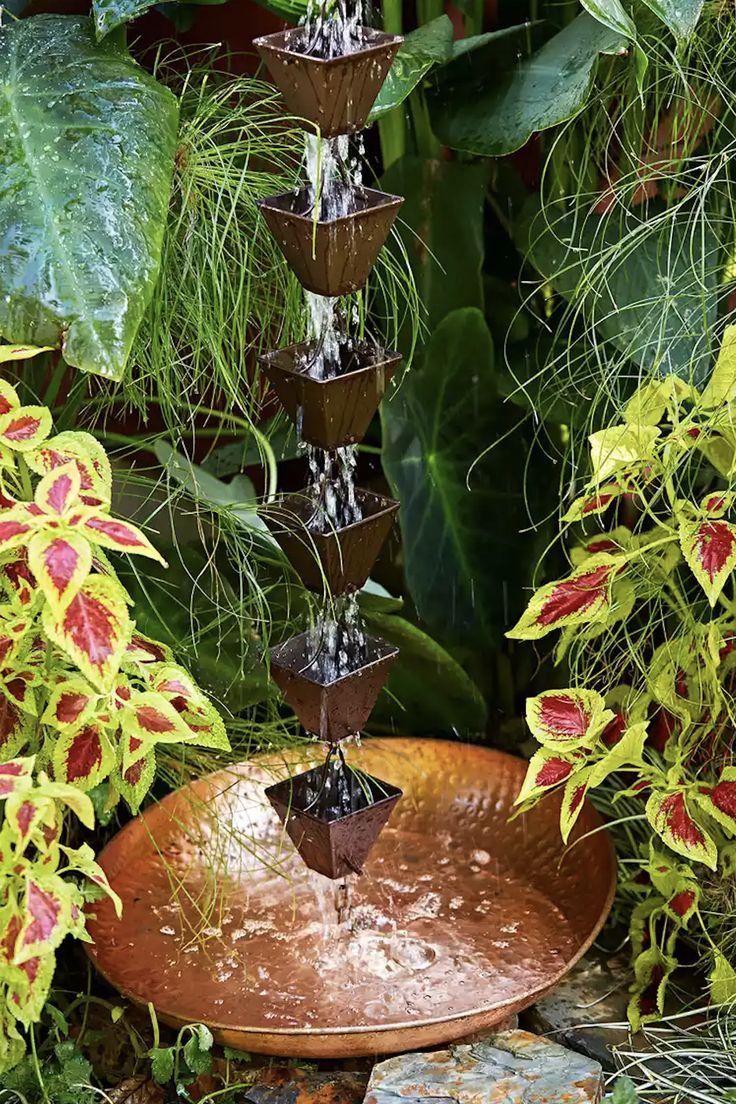 Rain Chain for Gard
Rain Chain for Gard
Image Source: Pinterest
2. Rainwater Harvesting
Rain chains can be an integral part of a rainwater harvesting system. By connecting the bottom of the rain chain to a rain barrel, you can efficiently collect and store rainwater for various household uses, such as gardening, cleaning, or even drinking if properly filtered. This practice promotes water conservation, reduces your water bill, and provides a sustainable solution for utilizing natural resources. In regions with frequent rain, a rain chain can significantly contribute to your household's water supply, making it an eco-friendly addition to your home.
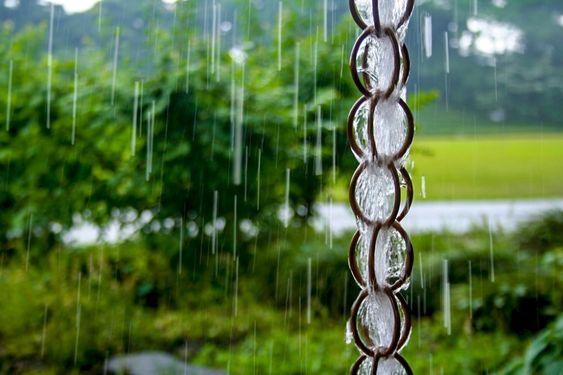 Rain Chain for Rainwater Harvesting
Rain Chain for Rainwater Harvesting
Image Source: Pinterest
3. Decorative Element
Integrate the rain chain into your garden sculpture or decorative pot to enhance the visual appeal of your outdoor space. For instance, you can install a rain chain that cascades into a beautifully designed ceramic pot filled with pebbles, creating a mini water garden. Alternatively, you can incorporate the rain chain into a garden sculpture that channels the water through various artistic elements before it reaches the ground. This creative use of rain chains adds an artistic touch to your garden, making it more aesthetically pleasing and unique.
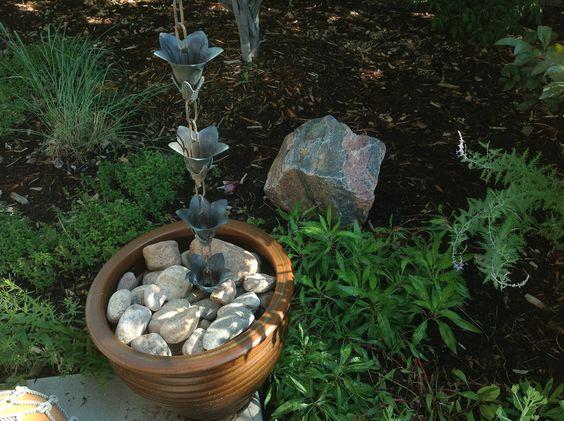 Decorative Po
Decorative Po
Image Source: Pinterest
4. Watering System
Direct the rain chain to a garden bed or planter to provide a natural watering system for your plants. As rainwater flows down the chain, it can be directed into specific areas of your garden that need watering. This method ensures that your plants receive natural, soft rainwater, which is often better for them than tap water. By strategically placing the rain chain, you can create an efficient irrigation system that reduces the need for manual watering. This setup is particularly useful during the monsoon season, ensuring that your plants receive consistent moisture without the risk of overwatering.
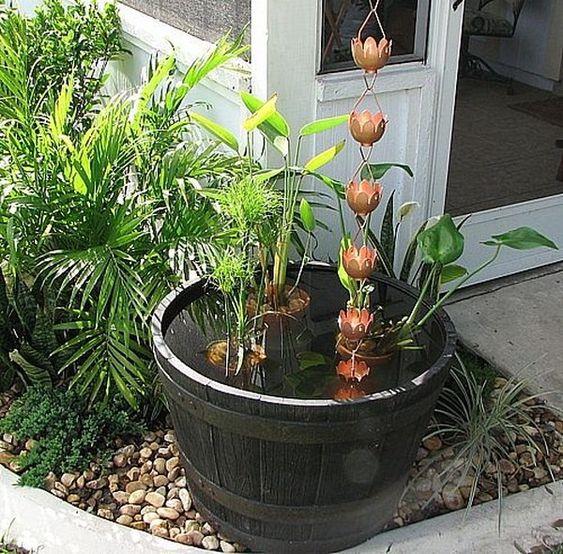 Rain Chain Watering Syste
Rain Chain Watering Syste
Image Source: Pinterest
Conclusion
Rain chains are a beautiful and functional addition to any home, especially in India, where monsoon rains are abundant. They offer a sustainable way to manage rainwater while significantly enhancing the aesthetic appeal of your home. The cascading water creates a serene and calming ambiance, adding a unique visual and auditory charm to your exterior.
By choosing the right design, installing it correctly, and maintaining it regularly, you can enjoy the numerous benefits of a rain chain for years to come. Whether for practical water management or as a decorative element, rain chains can transform your home's appearance and contribute to a more eco-friendly lifestyle.
explore further
Latest from Contemporary ideas
More from Innovations
Resources
Dwello, for every home buyer, is a way to go from 'I feel' to 'I know', at no extra cost.




